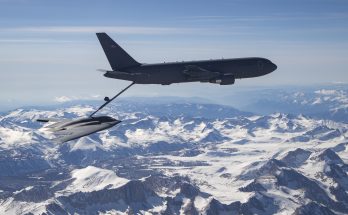On early Sunday morning, Tehran launched over two hundred drones and missiles toward Israel in response to an Israeli airstrike in Damascus, Syria on April 1, 2024. Below is an abbreviated timeline of events that occurred from April 1 through April 15.
Timeline
April 1, 2024
Israel sends aircraft to conduct an airstrike on an Iranian diplomatic compound in Damascus, Syria. The attack killed seven Iranian military advisors, including Brigadier General Mohammad Reza Zahedi and his deputy General Mohammad Hadi Hajriahimi. Both individuals were senior commanders in the Quds Force, a branch of the Islamic Revolutionary Guard Corps (IRGC). A Hezbollah member, Hussein Youssef, was also killed in the attack. The death toll, according to Iranian state media, was approximately 13 people.
The operation was met with statements of condemnation by Syria and Iran. Within the Gulf region, Kuwait, Oman, Qatar, Saudi Arabia, and the United Arab Emirates released statements condemning the attack. In a late-night meeting, Iran’s Supreme National Security Council agreed to respond to the attack.
Israel does not confirm or deny responsibility for the attack.
April 2, 2024
Iran’s Foreign Minister Hossein Amirabdollahian accused the United States (US) of authorizing the Israeli airstrike, a claim that the US denied almost immediately.
Tehran vowed to respond to the Israeli attack. Iran’s Supreme Leader, Ayatollah Ali Khamenei, stated, “We will make them regret this crime and other similar ones with the help of God.”
The Pentagon’s deputy press secretary, Sabrina Singh, states the US believes that Israel conducted the airstrike.
The United Nations Security Council (UNSC) holds an emergency meeting. The US Deputy Ambassador to the United Nations (UN), Robert Wood, told the UNSC that the United States was in direct contact with Iran regarding the airstrike.
Russia and China condemn the Israeli airstrike with both claiming it violated international law. Algeria, Slovenia, Switzerland, Sierra Leone, Guyana, and Ecuador directly condemned the attacks in their statements during the UNSC meeting. France, the Republic of Korea, Japan, and the United Kingdom expressed their concerns regarding both the airstrike, as well as the overall security environment in the Middle East.
April 3, 2024
On April 3, the European Union (EU) condemned the attack and called on all parties to practice restraint.
Lieutenant General Alexus G. Grynkewich, commander of the Ninth Air Force, made a statement claiming Iran’s accusation of US involvement in the attack on its diplomatic building could reignite militia attacks against US forces that were paused since early February.
Experts begin to speculate on Iran’s response, whether it will happen, or how and when it will occur. (Example 1, Example 2, Example 3) Speculation continues until the Iranian attack begins on April 14.
April 4, 2024
President Joseph Biden speaks to Israel Prime Minister Benjamin Netanyahu and reiterates the US’s strong support of Israel as Iran publicly threatens the state after the Damascus airstrike.
Israel places its military on high alert. GPS Signals were blocked in Tel Aviv.
April 5, 2024
The Iranian president’s deputy chief of staff for political affairs, Mohammad Jamshidi, posted on X (formerly Twitter) claiming that a written message from Iran was sent to the US. Iran tells the US to “step aside” in the event of an Iranian response to the consulate attack in Damascus.
Hezbollah’s leader, Hassan Nasrallah, claimed an Iranian response to the attack was inevitable. Nasrallah also encouraged people in the region to prepare for an Israeli response to an Iranian attack.
Iran holds a funeral for the seven IRGC members in Tehran. Once again, Iranian officials vow to avenge their deaths.
US officials confirmed that US military forces in the Middle East were placed on high alert in preparation for an Iranian response.
April 6, 2024
In Tehran, Iran’s joint chief of staff, General Mohammad Bagheri, told mourners attending the funeral that Iran will decide when and how it will stage an operation in response to the Israeli airstrike.
April 7, 2024
Israeli Chief of General Staff, Herzi Halevi, stated that Israel will be able to defend against any Iranian attacks.
Senior advisor to the Supreme Leader Ayatollah Khamenei, Yahya Rahim Safavi, stated that Israel’s embassies were no longer safe and any Iranian response was legal and legitimate.
April 8, 2024
US Secretary of Defense Lloyd J. Austin III speaks with Israeli Minister of Defense Yoav Gallant and affirmed “unwavering U.S. support for Israel’s defense in light of threats posed by Iran and its proxy network.”
April 9, 2024
In a post on X, Israel’s Foreign Minister, Israel Katz, said that Israel would respond to any Iranian attacks by retaliating with attacks of its own within Iranian territory.
The commander of Iran’s IRGC Navy, Alireza Tangsiri, said that Iran could close the Strait of Hormuz if Israel chooses to “disrupt” his country in any way, citing Israeli relations with the United Arab Emirates as a perceived threat to Iran.
Iran claims it notified the US that it would not respond to the Damascus airstrike if a ceasefire deal in Gaza is reached. The US denied these reports.
April 10, 2024
Speculation on US-Israeli defense coordination begins as CENTCOM Commander, General Erik Kurilla, is scheduled to meet with Yoav Gallant and other Israel Defense Forces (IDF) officials on April 11.
US Secretary of State Antony Blinken speaks with Yoav Gallant and reiterated US “support for Israel’s security and made clear that the U.S. will stand with Israel against any threats by Iran and its proxies.”
April 11, 2024
Israeli Defense Minister Yoav Gallant spoke with Secretary of Defense Lloyd Austin and informed him that “a direct Iranian attack will require an appropriate Israeli response against Iran.” Secretary Austin reiterated that Israel can rely on “full U.S. support to defend Israel against Iranian attacks.”
CENTCOM Commander General Erik Kurilla arrives in Israel. US officials claimed that additional assets were moving to the Middle East region to increase deterrence and force protection.
The US Embassy in Israel placed travel restrictions on US government employees and family members until further notice. France ordered family members of diplomatic staff in Tehran to leave and told its citizens to avoid travel to Iran, Lebanon, Israel, and the Palestinian territories.
April 12, 2024
During a press conference, US President Joseph Biden stated that he expected Iran to attack Israel and warned Iran to resist any response to the Damascus attacks by saying, “Don’t.”
General Erik Kurilla and Yoav Gallant discussed the potential Iranian attack. Gallant said that Israel was prepared to defend itself and it was working in close cooperation with its partners.
A US official told the Wall Street Journal that an Iranian retaliatory strike could occur within days and possibly on within Israel’s borders. The article’s URL now redirects to another titled, “U.S. Moves Warships to Defend Israel in Case of Iranian Attack”. Fortunately, a kind soul archived the original article for us.
The US moves its warships to more favorable positions in preparation for an Iranian retaliatory strike against Israel.
Iran Attacks: April 13 – 14, 2024
Iran’s attack begins with an initial wave of drones launched from Iran toward Israel. The attack began late Saturday night and continued until Sunday morning, approximately five hours. One hour after the drones were launched, the IRGC claims they launched ballistic missiles so they would arrive at their targets at the same time.
Approximately 170 drones, 30 cruise missiles, and 110 ballistic missiles were launched from several countries. Missiles and drones were launched from Iran, Iraq, Syria, and Yemen. Hezbollah fired two barrages of rockets from Lebanon toward the Golan Heights.
Israel
Israel successfully defended against the attack through its sophisticated air defense systems Iron Dome, David’s Sling, Arrow 2, and Arrow 3 systems. One of the targets, perhaps the main target, for Iran’s ballistic missiles was the Nevatim Airbase where F-35I and F-16I aircraft reside and where the attack on the Iranian consulate in Damascus was supposedly launched. Israel claims to have downed “dozens” of drones with Israeli Air Force aircraft.
United States
The most impressive of interceptions came from the US. The USS Carney (DDG-64) and USS Arleigh Burke (DDG-51) intercepted between four to six ballistic missiles. Patriot missile defense systems in Iraq shot at least one ballistic missile violating Iraqi airspace. The 494th Fighter Squadron and 335th Fighter Squadron also participated in defending against the Iranian attack. Both squadrons used F-15E Strike Eagle aircraft and successfully shot down approximately 80 drones.
Other Partners
The United Kingdom participated by using Typhoon fighter jets to shoot down Iranian drones. France also assisted by patrolling airspace and also shot down Iranian drones over Jordan.
Jordan intercepted at least one missile flying through its airspace. Jordan is equipped with both advanced radar systems and F-16s that allowed its military to successfully accomplish its mission. Jordan also allowed US and coalition military aircraft to fly in its airspace.
Saudi Arabia and the other Gulf states provided intelligence to the US and Israel after Iran sent Gulf states forewarning of its inevitable attack.
Result of the Iranian Attack
The defense of the Iranian attack proved to be an incredible success. It is reported that the vast majority of the over 300 missiles and drones launched by Iran were intercepted. Israel Defense Forces Rear Admiral Daniel Hagari highlighted the interception as a “very significant strategic success,” with 99% of the incoming threats being neutralized. The interceptions were primarily handled outside Israel’s borders. The U.S. also played a significant role, assisting in the downing of nearly all threats through deployments of aircraft and missile defense systems.
What Happens Next?
The Iranian attack against Israel was met with condemnation from many world leaders. The UN, through Secretary-General Antonio Guterres, called for restraint as tensions in the region reach unseen heights. The US continues to pledge its support for Israel but will consult with G7 leaders to coordinate a plan for a diplomatic response which could result in more sanctions against the Iranian regime and other entities. Iran’s mission to the UN warned the US and others to avoid direct involvement in the conflict. Iran continues to threaten Israel, warning that a retaliatory strike would result in a more severe response. Israel’s Minister of Defense, Yoav Gallant, recently told Defense Secretary Lloyd Austin that a retaliatory strike by Israel was imminent. Gen. Herzi Halevi spoke with a similar tone, stating that Israel is currently considering its options and that Iran’s attack deserves a response.
Reality can sometimes be less desirable than our hopes and wishes. The events and statements made in the aftermath of the Damascus strike show that world leaders will condemn actions and threats, attempt to de-escalate through back channels, and seek diplomatic resolutions to conflicts. As this was happening, Israel and its partners were preparing for an unprecedented attack from Iran. The resources used by Iran to conduct an attack and the defense against it by Israel and its partners show that a response from Iran was inevitable and everyone involved knew it.
For those of us on the outside, looking in, the most we could do was wait for the Iranian retaliatory attack to happen. We will likely do the same thing for Israel’s response regardless of how many leaders warn against it and try to diffuse the situation diplomatically. How Israel responds will be up for debate until it occurs, and Iran’s response will be even less discernible. The big question is how long can this tit-for-tat last until the security environment in the Middle East collapses? We’ll have to wait and see.




